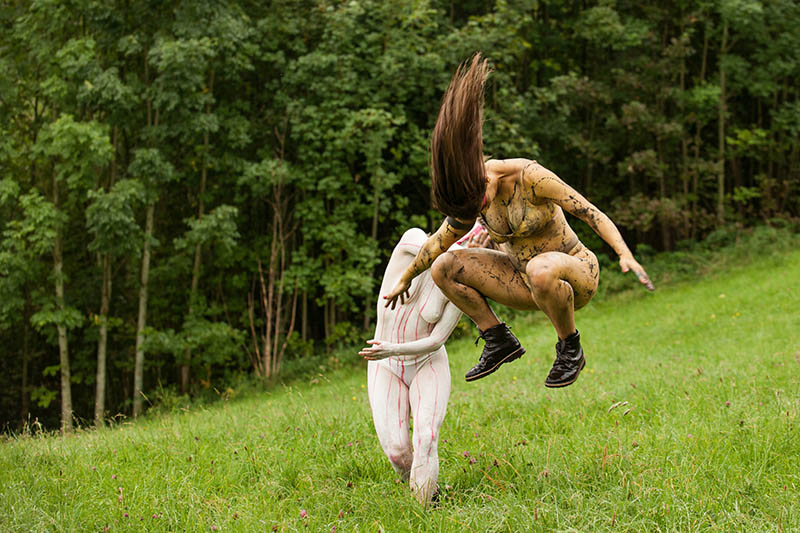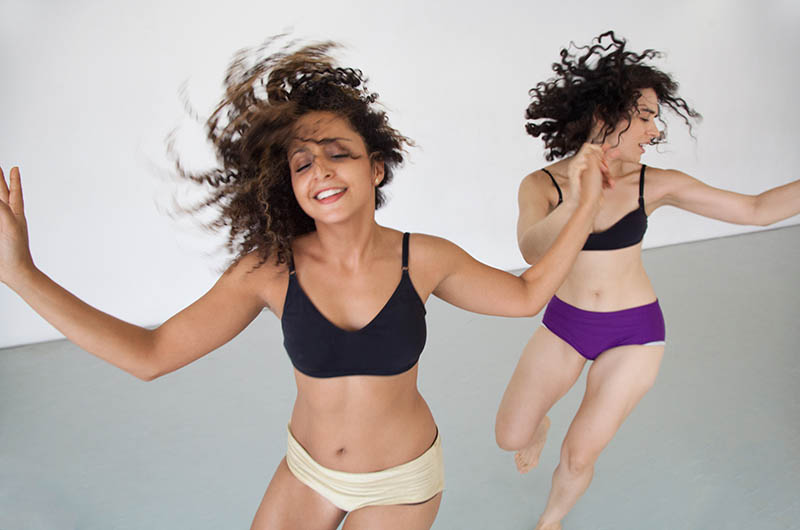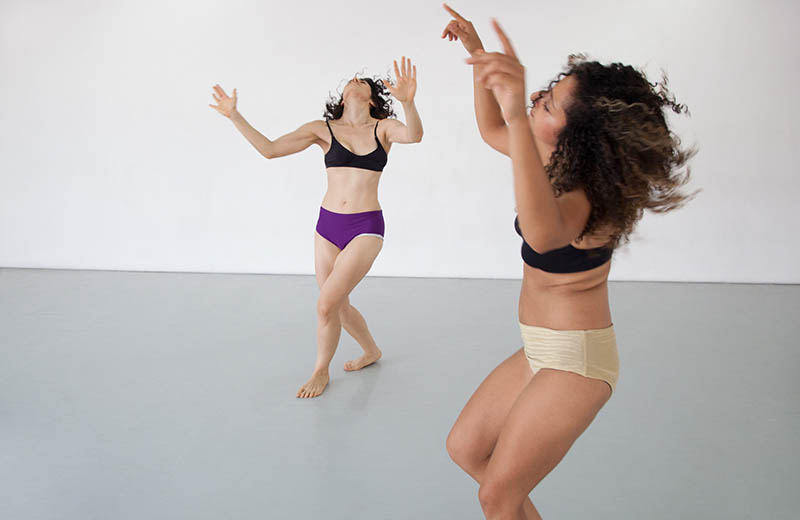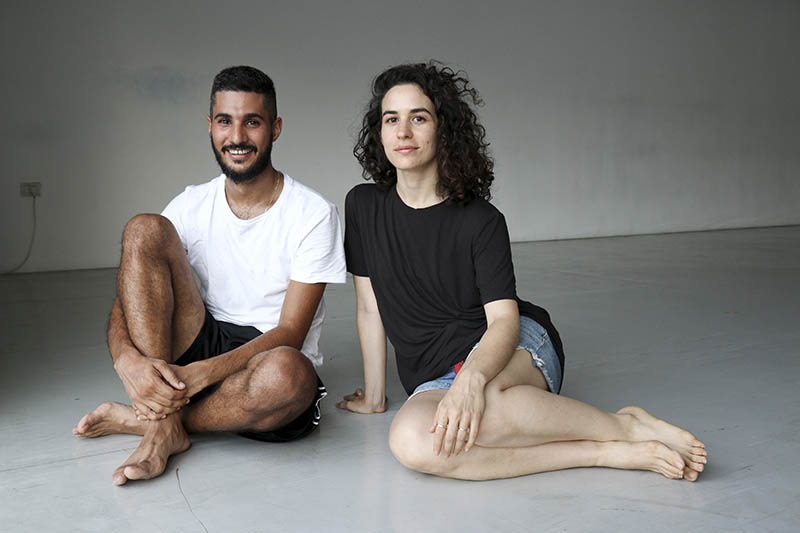Becoming Critical Bodhis
I am haunted by the books I have read in the past. The specter of Sartre's Self-Taught Man is still looking over my shoulder, worried that there is still a universe before me and there might not be enough time. But that is only half the problem, for I, like the narrator of Patrick Suskind Amnesia in Litteris, have already forgotten the books I had once read. I share these thoughts with the dancers of Bodhi and I can see that they are not sure where I'm heading. I wish to elucidate my intentions as I read out loud Suskind's words: "Reading is an act by which consciousness is changed in such an imperceptible manner that the reader is not even aware of it. The reader suffering from amnesia in litteris is most definitely changed by his reading, but without noticing it, because as he reads, those critical faculties of his brain that could tell him that change is occurring are changing as well." I look at the still-not-convinced faces of the Bodhis and put my thoughts into words: "reading together, I hope, will do something similar, open up a critical space where we can follow Rilke's imperative: 'You must change your life!'"
"Dancing Bodies", an essay by dance scholar Susan Leigh Foster, served as a starting point for a reflection on the dancers' body-of-ideas – a term used by Foster to describe the result of the daily practical participation of a dancer's body in different disciplines. We also wished to situate this body – as Foster does in her essay – in a cultural and aesthetic moment, especially since the "hired body" which Foster describes in her article as a new kind of body, "competent at many styles," has become the focal point of the horizon of expectations in contemporary dance training. This reflection proved to be enriching also in regards to the creative process the dancers have began working on; Cecilia Bengolea's use of different styles of dancing, and her reliance on the different dance techniques the dancers embody seemed to realize Foster's apprehending of the body as "multiple, protean, and capable, literally, of being made into many different expressive bodies."
However, Foster's critical attitude towards the construction of this eclectic body did not go unnoticed. We pushed this critical view further also in regards to the on-going creation process, and read three extracts of texts that address the politics of inclusion and exclusion in a globalised dance field. The first was "Global Breakdancing and the Intercultural Body" by Halifu Osumare, scholar of black popular culture, choreographer and dance educator. It ends with the sentence: "global capitalism and evolving hip hop subculture exist in parallel, yet intertwined, forces in this increasingly complex era", which echoed the discussion Cecilia had with the dancers regarding the appropriation of Jamaican Dancehall. Likewise, Bojana Kunst, philosopher and performance art theorist, in her essay "Subversion and the Dancing Body: Autonomy on Display", describes how "otherness" comes across as commodity in the dance market, but also argues that contemporary choreographers employ different strategies to "expose contemporary subjectivity as a process of performing, always confined within a complex network of potentiality and relations." Into this charged space entered the third text by choreographers Thomas Plischke and Kattrin Deufert, "(Not) Being Able to Speak Oneself" which documents the creation process of (Nao) se pode falar in Andarai, a local slum in Rio de Janeiro. Discussing it, we questioned the writers' point of view, and their capability to perceive reality other than as white, European privileged choreographers. We did not arrive to unequivocal conclusions.
Reflecting on both the creation process and the reading sessions I thought it would be beneficial to discuss how criticality changed the choreographic practice and the perception of the performing bodies. Therefore I introduced art scholar Céline Roux's essay "Performative Practices/Critical Bodies #2: What Makes Dance". Roux's essay outlines a contextual reflection on the dancing body in what she calls 'performative practices', or in her own words: "it is about the construction of reflective and reflexive thinking processes that suggest new ways of being in the world." Though it was far too early to discuss Cecilia's work-in-progress, let alone whether it aligns with the practices Roux describes, I found her preeminent claim that "the body is a place for a critical discourse" of great importance for the dancers. In addition, Roux's essay is abundant of examples of French choreography, thus it was helpful in situating Cecilia's work in a historical, if not aesthetic, timeline. Moreover, these choreographic works exemplified the wide spread of what dancing in a contemporary choreography might mean today.
These last aspects of the article turned out to be meaningful for the dancers, who didn't know all of the examples, and so we spent time watching and discussing them. We also dedicated a session to the ways dancers became creative collaborators since that defining moment when - as André Lepecki puts it in words: "Pina Bausch dared to ask dancers a question." According to Lepecki, "by positioning the dancer in the place of producer of knowledge rather than passive recipient of previously elaborated steps, and by allowing the dancers' expressivity to escape from the self contained realm of "pure movement", Bausch was changing the entire epistemological stability of the dance field." And so, through on-line video documentation of performances and rehearsals we examined the ways in which Pina Bausch, Vera Mantero and Meg Stuart work with their dancers. These different examples were meant to empower the dancers in the creative process and inform them of the open, divergent opportunities it offered them.
Implementing a reflexive attitude towards my own doing, as well as thinking of the dancers as collaborators, I asked the dancers where they want to steer the boat next. The dancers expressed a wish to further deepen the issues we have discussed but also a concern that they don't know enough the field of contemporary dance – literally names of choreographers and companies. Here, since I felt I am sharing with the dancers – as the choreographer does, according to Lepecki – the same premise of departing from "not knowing" and using dance as a field of knowledge, I suggested we start by mapping what we do know, and that we do so in collaboration. This is how we entered a new and unexpected phase in our joint trajectory: cartographing hidden knowledge. Therefore, we created a list of names of dance companies and dance makers, divided to categories suggested by the dancers, reflecting a subjective view of the field, and actually a contested one since we didn't agree on sorting the names into categories. Later on, we created in a similar way a list of dance festivals and suggested different categories in which they could be sorted. Thus, creating these lists served as a basis for discussion of aesthetics, dance history and (again) politics of inclusion and exclusion – which is always present when it comes to the production of knowledge. We then used the lists as a source for each of the dancers to research and present a dance maker or a company whom she didn't know beforehand.
Since the ontological question of dance (namely: is it dance?) came up (in response to the work of La Ribot, presenting at the time at "Tanz im August") – I felt we need to discuss the medium's apparatus and its expansion. We did that by watching online Yvane Chapuis and Jérôme Bel, conversing upon his performance The show must go on (2001). This performance, as well as their discussion of it, enabled us to point out some of the influences "conceptual dance" had on the contemporary dance scene at large, and to recognize how the mainstream is changing as a consequence of what is going on at the more experimental parts of the field. We paid special attention to the presence of popular culture representations, since they were also present in the on-going creation process Cecilia was conducting at the time. We furthered this discussion while reading Rudi Laermans' essay "The politics of collective attention", in which he argues that "the performing arts cannot avoid reproducing or disputing the dominance of the mass media since they work with the very same medium of sensory attention."
Also in regards to creative work done at the studio at the time, I thought it would be of interest to examine the ways in which the body on stage, or dance in general – considered a non literal art form – actually "says" something, and specifically I wished to focus on what it "says" about the culture we live in. Therefore, using the work of several Israeli choreographers (Roy Assaf, Sharon Eyal, Ohad Naharin, Dana Ruttenberg, Niv Sheinfeld, Oren Laor and Keren Levi) as example, I asked the dancers to consider the ways in which culture is always inscribed in the body, as well as the diverse ways in which choreographers employ the dancing body to reflect that culture. However, when we discussed the following meeting the use of the dancer's body by the choreographer in regards to Laermans' article – the dancers were uncomfortable with thinking of themselves as being mere "manifestations of the body overlooked within the spectacle society." The question of their subjectivity came up, especially in the practical aspect of "performing themselves" – or to put it in other words: the dancers where concerned how they can be individuals with agency and not just vessels for the choreographer's whims. This became the subject of our last sessions.
The "performance of the self" stood at the heart of our discussion, first as it was framed by sociologist Erving Goffman, and later through the artistic work of Cindy Sherman and David Lachapelle, both chosen also because of their affinity to the mass media representations of the body and the self, a theme which has been accompanying our discussions throughout the passing weeks. Thinking of the self as a non fixed entity, always changing, complicated even more the question of how to perform oneself. This, we realized, is a question to be answered by practice, and luckily we have the studio and the stage as playgrounds for such experimentation, though it expands beyond the limits of these sites. It remained an open-ended question for the dancers to explore.
***
For the past five weeks we have been pursuing dance as a field of knowledge, following breadcrumbs and fishing for the unknown, gleaning hidden knowledge, sometimes our own, sometimes implicit in the work of the choreographer, shedding light on history, aesthetics and politics embedded in our practice. We did so by reading, conversing, translating, over and over again, aided by Youtube from time to time, whenever there were gaps to be filled, only so that we could continue unfolding questions of this expanding art form we chose to take part in. We have been questioning the medium at large, the on-going studio-work, the theory input itself, and ourselves; questioning, but not doubting, since by doing so it became more and more clear that dance is indeed a field of knowledge, a site for the critical to appear in, a call for the dancers and spectators as one to change their lives.
(by Ran Brown)
Bibliography
Deufert, Kattrin, Thomas Plischke. "(Nao) se pode falar (Not) being able to speak oneself." Performance Research 8.2 (2003): 42-45.
Foster, Susan Leigh. "Dancing bodies." Meaning in motion: New cultural studies of dance (1997): 235-257.
Kunst, Bojana. "Subversion and the dancing body: Autonomy on display." Performance Research 8.2 (2003): 61-68.
Laermans, Rudi. "The politics of collective attention." Knowledge in Motion: Perspectives of Artistic and Scientific Research in Dance 9 (2007): 235. Available online at: http://sarma.be/docs/1313
Lepecki, André. "Dance without distance (The collapsing barriers between dancers, choreographers, critics and other interested parties)." BALLETT INTERNATIONAL-TANZ AKTUELL 2 (2001): 29-31. Available online at: http://sarma.be/docs/606
Lepecki, André, ed. Dance. Whitechapel Gallery, 2012.
Osumare, Halifu. "Global breakdancing and the intercultural body." Dance Research Journal 34.2 (2002): 30-45.
Roux, Céline. "Performative Practices / Critical Bodies # 2:What Makes Dance." Danse: an anthology, New York, Les presses du réel, New York Series, 2014
Süskind, Patrick. 1986. “Amnesia in litteris. The books I have read (I think)”, Harper's magazine (March 1987): 71-73.




